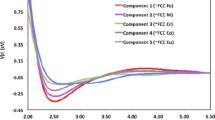Abstract
Tensile and creep deformation of 304 stainless steel have been studied at room temperature in a soft tensile machine. The strain-stress curve shows a long inelastic transient, over nearly two hundred megapascals, in which the slope and the strain rate increase by about a factor of 3. Creep is characterized by large creep strain, transient strain rate, and a weak stress dependence. The stress rate applied during loading, on the other hand, has a strong effect on the subsequent creep. These results, in combination with earlier studies, have suggested a new model for the evolution of mobile dislocation density. Mobile dislocations are injected into the sample as a consequence of the increase of stress; the dislocations move under the influence of an effective stress over a statistical mean free path and then are trapped in a network. The effects of trapping are reduced mobile density, strain hardening, and a decrease in the effective stress. Application of the model provides a quantitative prediction of the principal experimental results.
Similar content being viewed by others
References
H. Conrad and W. D. Robertson:Trans. TMS-AIME, 1957, vol. 209, p. 503.
H. Conrad and W. D. Robertson:Trans. TMS-AIME, 1958, vol. 212, p. 563.
J. H. Holbrook, R. W. Rohde, and J. C. Swearengen:Acta Metall., 1981, vol. 29, p. 1099.
T. H. Alden: inMechanical Testing for Deformation Model Development, R. W. Rohde and J. C. Swearengen, eds., ASTM STP 765, ASTM, Philadelphia, PA, 1982, p. 29.
T. H. Alden:Metall. Trans. A, 1985, vol. 16A, p. 375.
T. H. Alden:Phil. Mag., 1972, vol. 25, p. 785.
T. H. Alden: University of British Columbia, Vancouver, BC, un- published research, 1985.
J. J. Gilman and W. G. Johnston:J. Appl. Phys., 1959, vol. 30, p. 129.
J. J. Gilman:Micromechanics of Flow in Solids, McGraw-Hill, New York, NY, 1969.
U. F. Kocks:Metall. Trans., 1970, vol. 1, p. 1121.
A. S. Keh:Phil. Mag., 1965, vol. 12, p. 9.
J. D. Livingston:Acta Metall., 1962, vol. 10, p. 215.
J. E. Bailey and P. B. Hirsch:Phil. Mag., 1960, vol. 5, p. 485.
G. I. Taylor:Proc. Roy. Soc. A, 1934, vol. 145, p. 362.
G. Saada: inElectron Microscopy and the Strength of Crystals, G. Thomas and J. Washburn, eds., Interscience, New York, NY, 1962, p. 651.
W. A. Coghlan, R. A. Menezes, and W. D. Nix:Phil. Mag., 1971, vol. 23, p. 1515.
B. Reppich, P. Haasen, and B. Ilschner:Acta Metall., 1964, vol. 12, p. 1283.
W. G. Johnston and D. F. Stein:Acta Metall., 1963, vol. 11, p. 317.
H. Mecking and K. Lucke:Scripta Met., 1970, vol. 4, p. 427.
T. H. Alden: University of British Columbia, Vancouver, BC,Metall. Trans. A, 1987, in press.
O. H. Wyatt:Proc. Phys. Soc, 1953, vol. 66B, p. 459.
F. Garofalo:Fundamentals of Creep and Creep Rupture in Metals, MacMillan, New York, NY, 1964.
Author information
Authors and Affiliations
Rights and permissions
About this article
Cite this article
Alden, T.H. Theory of mobile dislocation density: Application to the deformation of 304 stainless steel. Metall Trans A 18, 51–62 (1987). https://doi.org/10.1007/BF02646221
Received:
Issue Date:
DOI: https://doi.org/10.1007/BF02646221




